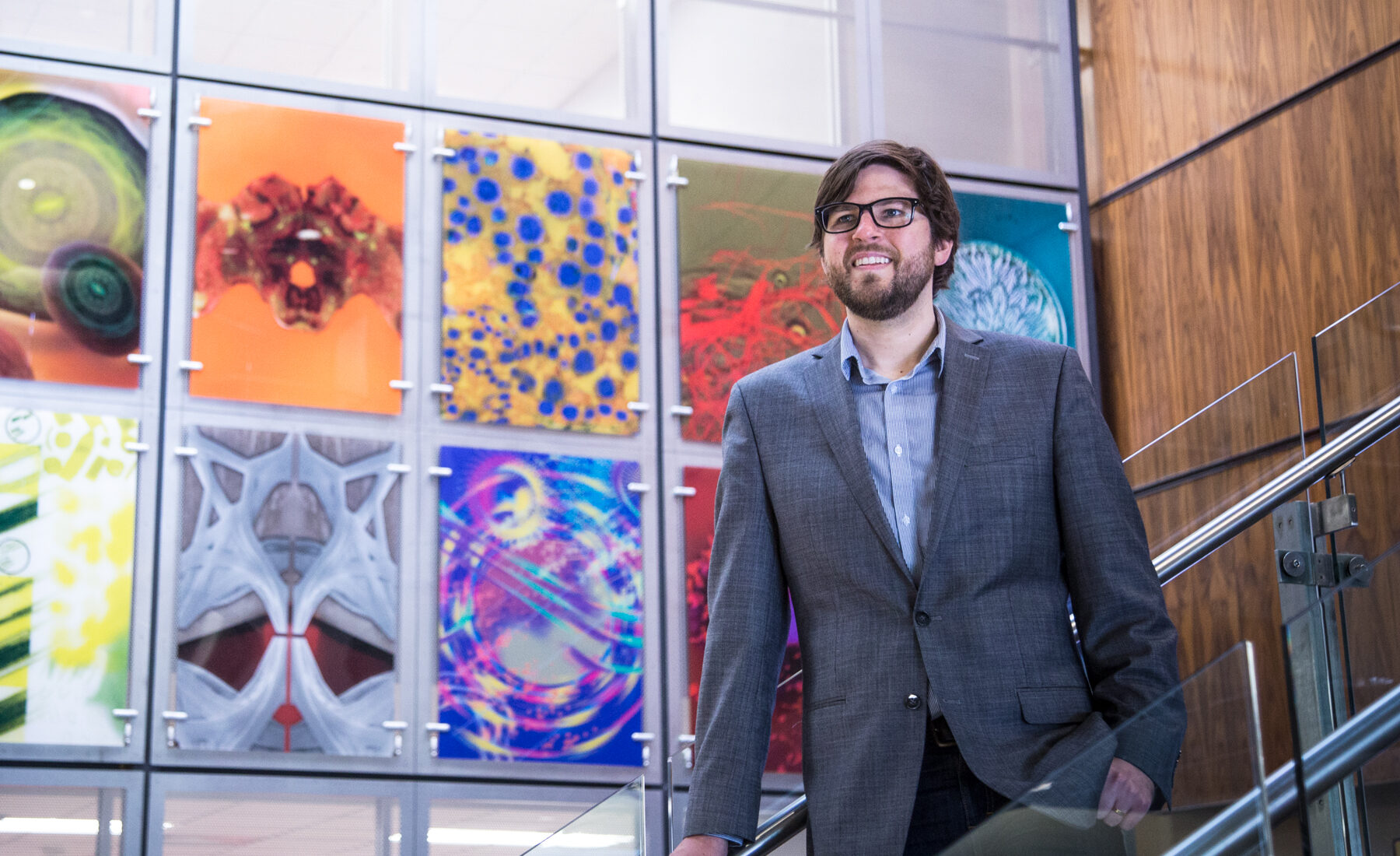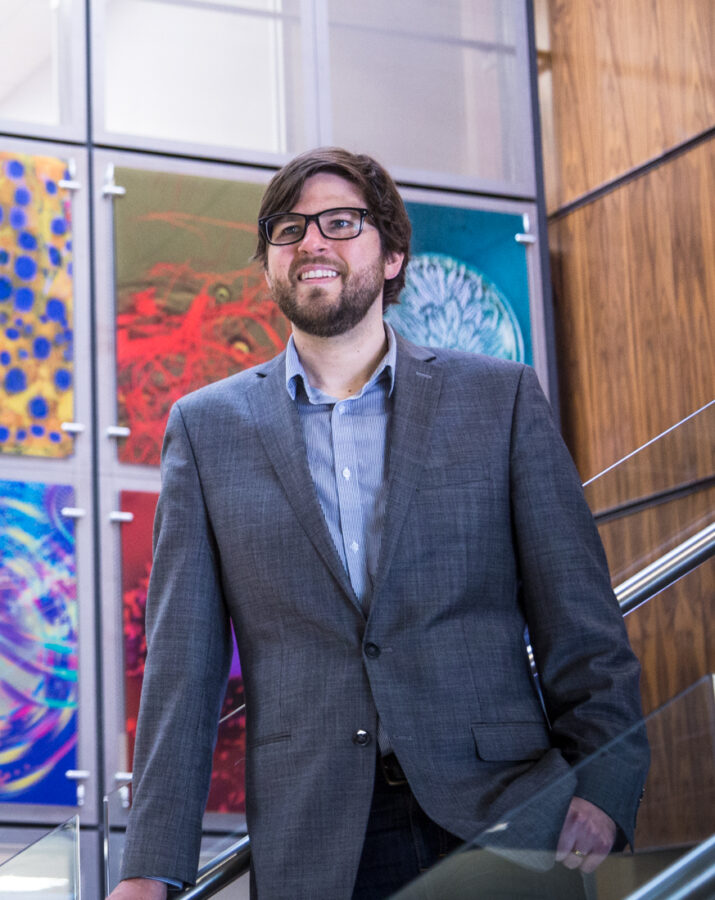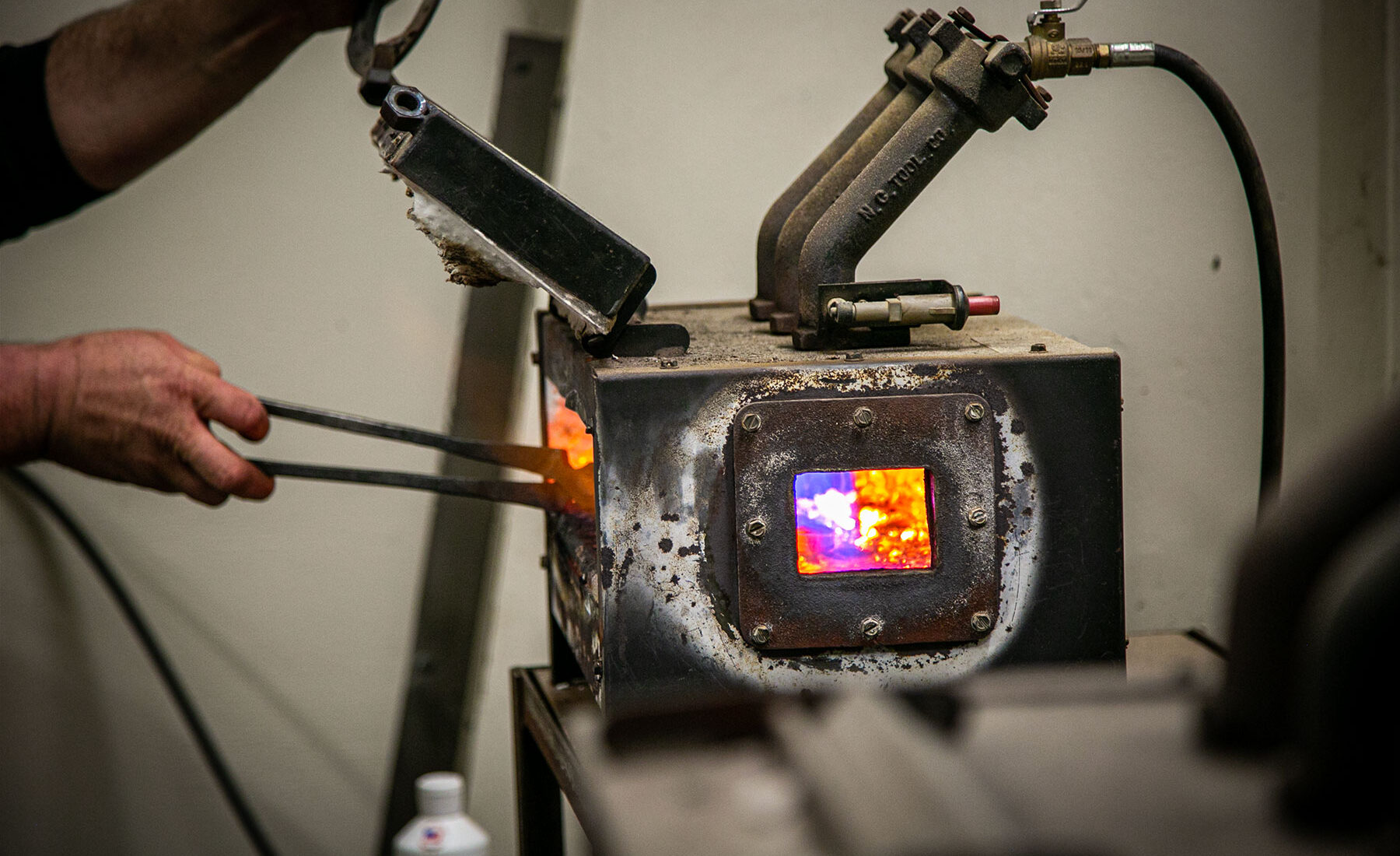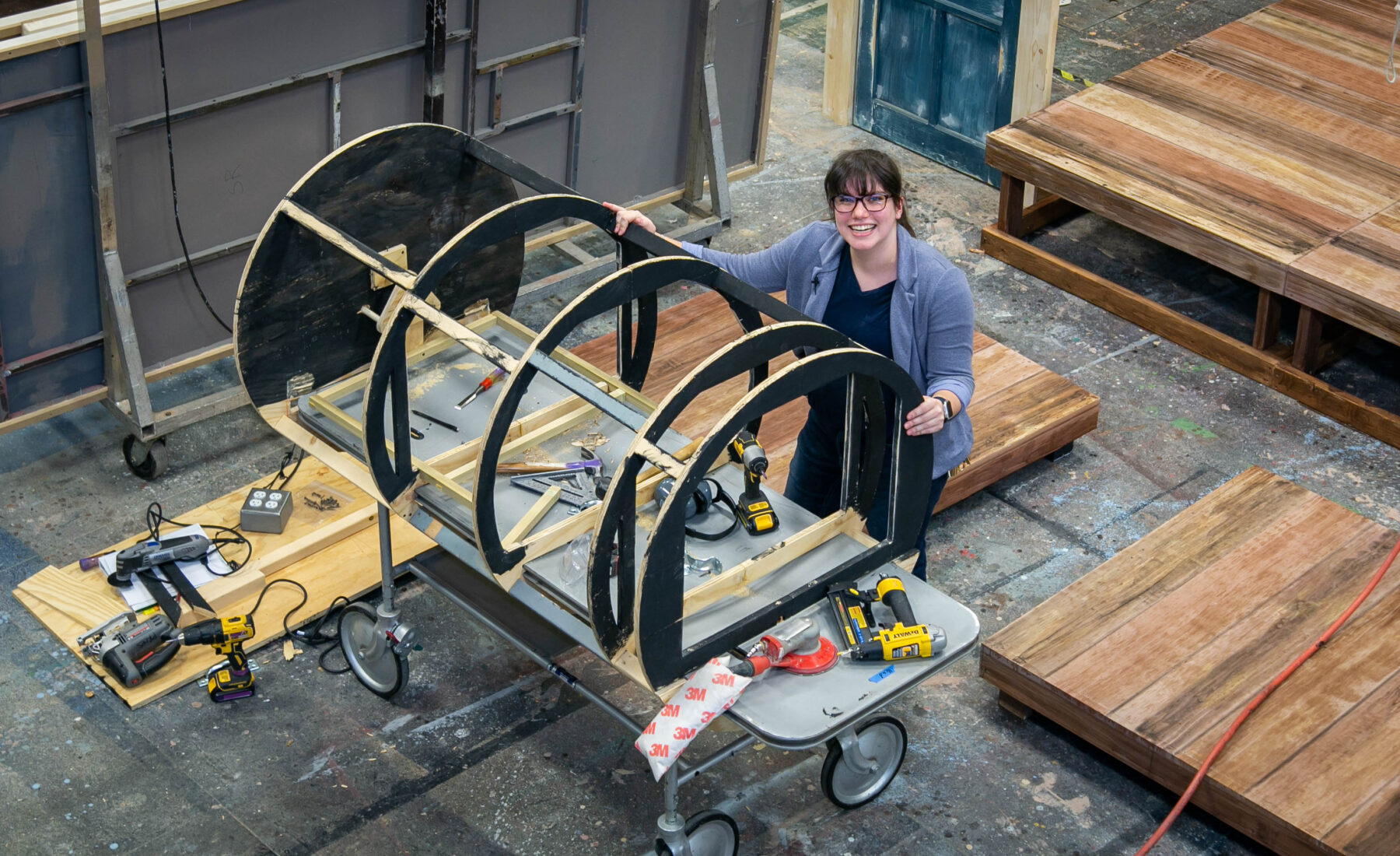Dr. Michael C. Saul breezes through the glass doors, leading a group of students on a tour of his lab. He guides them past a low wall where a series of white lab coats hang from hooks, toward rows of slate black lab countertops that are scattered with half-opened cartons of test tubes, boxes of Reynolds Wrap foil, and the latest research-grade microscopes. There are refrigerators at the far end of the counters, but you are more likely to find tissue samples or a honeybee head inside than a scientist’s lunch.
Michael is a postdoctoral fellow at the Carl R. Woese Institute of Genomic Biology (IGB) at the University of Illinois in Urbana-Champaign, where scientists conduct research around eleven research themes. Three years out from his Ph.D. in zoology from the University of Wisconsin-Madison, he is now part of the Gene Networks in Neural and Developmental Plasticity group of researchers.
That group is headed up by Dr. Lisa Stubbs, a professor of cell and developmental biology. Today, Michael has brought the group of students to the Stubbs Lab which occupies one half of the long, brightly-lit room. The Stubbs Lab studies genetics in mice, using mouse behavior paired with large-scale datasets to find networks among genes as well as to track the evolution of gene expression, including mutation and disease, over time.
The other half of the room houses the honeybee lab of famed scientist Dr. Gene Robinson, member of the National Academy of Sciences, director of the IGB, and as Michael puts it, “an intellectual force behind the honeybee genome project.” As a young scientist, Michael benefits from the proximity of and mentoring from accomplished scientists such as Gene and Lisa, who support him as he takes his science in new directions.
Most recently, Michael and his colleagues, including psychology professor Dr. Justin Rhodes, have been studying the relationship between gene expression and exercise behavior among mice. In a recent paper published in the journal Genes, Brain and Behavior, they explore the connection between what we usually consider to be a decision fueled by motivation (do I want to go to the gym today?) to see how much of that yes or no answer is actually rooted in our genetics.
Mice paws running on wheels may mirror our feet hitting the treadmill, but there is another reason biologists use mice in their research: mice share 98% of the genes in their genome with humans. This, coupled with the fact that the mapping of the mouse genome is widely considered to be a highly accurate collection of data, makes them an important part of genomic research. “We continue to study mice because, in part, the tools are second to none,” Michael explains.
A revolution begins
The research that Michael conducts today actually began sixty-six mouse generations ago. It was 1992, and Michael was seven, unaware of genomics. Perhaps even unable to spell it. The term was only slightly older than Michael himself, having been coined six years earlier by geneticist Tom Roderick over a beer with colleagues at a conference held to explore mapping the human genome.
Every so often this is how it happens: A critical mass begins to form around an idea. That idea begins to embed itself in the minds and work of our scientists, our artists, our writers. In a way that seems nearly magical (but is most certainly, painstakingly, logical and scientific) our worldview begins to shift. To revolve and to evolve until we discover something wholly new. The Renaissance. The Industrial Revolution. The Digital Revolution.
For Tom and hundreds of scientists in sterile labs and high-speed computing centers (and eventually Michael), this was the beginning of the Genomic Revolution. And it is fundamentally changing the way we understand biology.
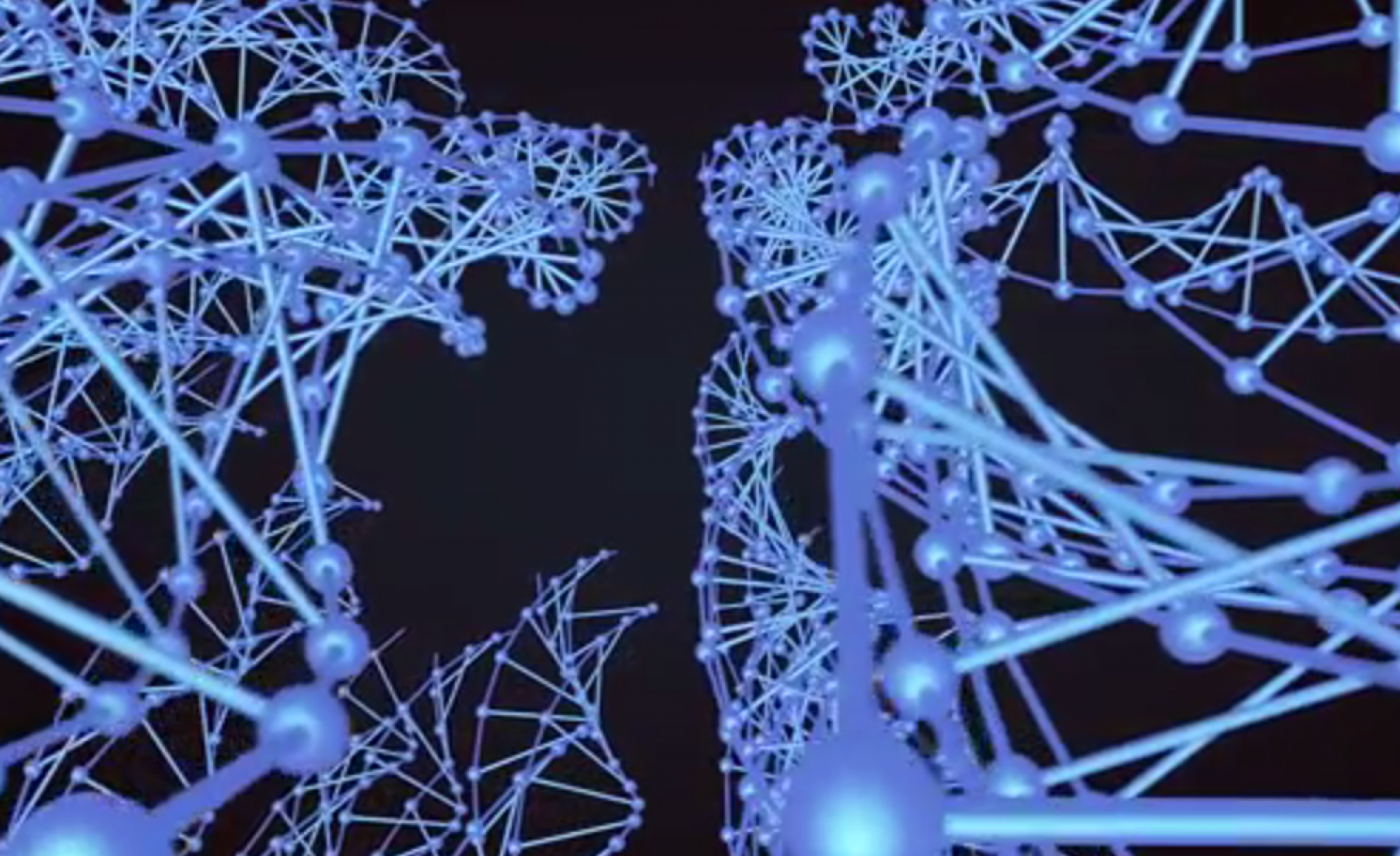
The revolution had not yet begun when one of Michael’s mentors, biologist Ted Garland of the University of California, Riverside, began selectively breeding the first generation of his mice. Twenty-five years and a genomic revolution later, Michael and his colleagues have now used the many-great-grandchildren of those mice to discover a strong connection between genetic control of our neural activity and our motivation to exercise.
“Motivation has a genetic component we didn’t realize was there,” said Michael, “but we’re also finding out epigenetics plays a part as well.”
Studying a structure
There are roughly 20,000 genes in the complete mouse genome. High-speed computing has allowed for deep analysis of the way some of those genes interact in clusters and the way bridges between those clusters make new links.
Studying those clusters and bridges has led Michael to uncover a bridge between the genes that relate to neural signaling and a cluster of genes that relate to the physical structure of a gene’s chromatin. Chromatin is what scientists call a complex, an item made of more than one biological molecule. In this case, chromatin is made from DNA and a protein called histone. Michael likens chromatin to a yo-yo. If the string (DNA) is wrapped tightly around the yo-yo (the histone), it is much harder for other cells to access and read the DNA. The measurement of how tightly wound chromatin is, according to Michael’s research, may be related to the movement between neural cells of dopamine and serotonin, both chemicals that regulate the way we feel pleasure and motivation, as well as balance our impulses and our mood. If the chromatin structure of a gene is too tightly or loosely wound, Michael’s work posits that it will affect the way serotonin or dopamine signal between the cells, potentially affecting the amount of motivation a mouse feels to exercise.
The interaction of chromatin in this way is an important element of the study of epigenetics.
“What we think we found is that dopamine signaling is regulated by serotonin receptors which are themselves regulated by chromatin structure—and all of these things are related to exercise behavior,” he said. “These genes are correlated with running, and they are also correlated with one another and so we think they are a system that is responsible for controlling running.”
Anything but basic
Though it is, at its essence, complex, scientists call this type of work “basic research” because the knowledge it produces lays the foundation for subsequent discovery. Michael and his team’s work on the genetic underpinnings of motivation in relation to exercise may well have implications for future scientific research into other human behaviors. In graduate school, for example, Michael worked with a related strain of mice and found that not only did this selected group have high exercise behavior, but they also showed behaviors related to mania. Michael therefore speculates that the same genetic framework for motivation may have a relationship to the brain’s expression of bipolar disorder.
“In order to understand nature in all its grandeur and know systems well enough to come up with things that are important, we have to do a lot of really basic science first,” he said. “Oftentimes we won’t necessarily know what good information will come out of basic science like this, so I’m speculating when I say I think this may have some relationship to bipolar disorder—and it is important to state that I’m speculating—but it very well could.”
Of course, scientific discovery begets scientific discovery, so don’t get ready to pop a pill and lace up your gym shoes. Uncovering the relationship between these genes clusters, for now, leads to further questions and paths of exploration. The next step in the research will be to directly measure chromatin and begin to test whether or not pharmaceutical drugs will have any effect on motivation levels and behavior.
“We’re still trying to identify these basic processes and understand how chromatin structure works, so this is a signpost pointing the way to say that epigenetics, chromatin structure itself, is the frontier we’re most interested in right now,” Michael said.
This story was published .